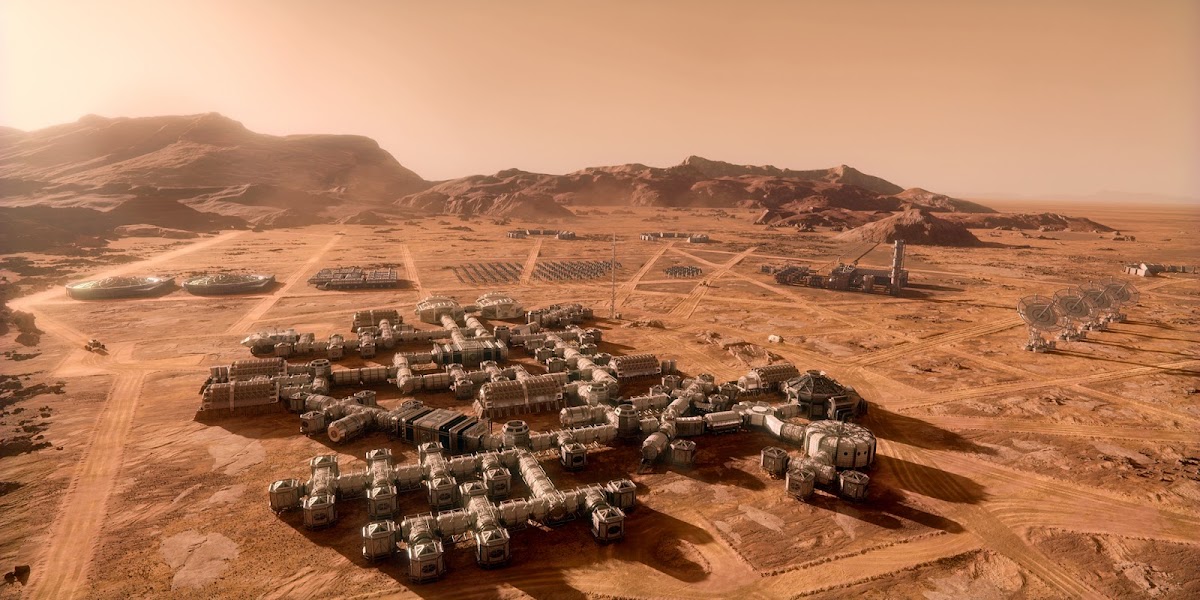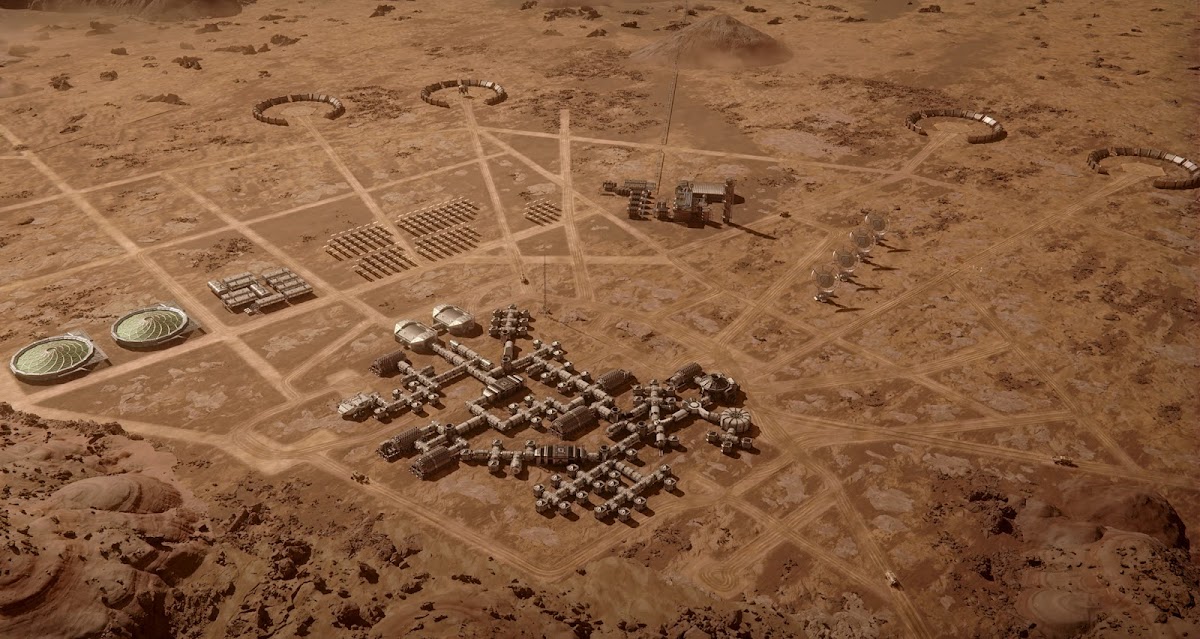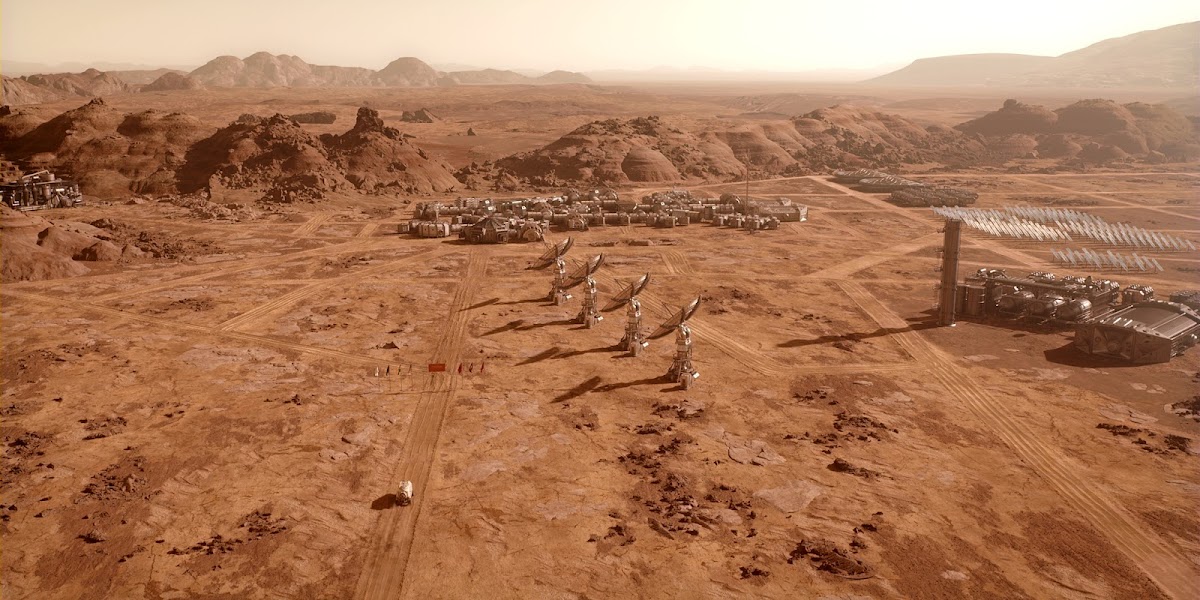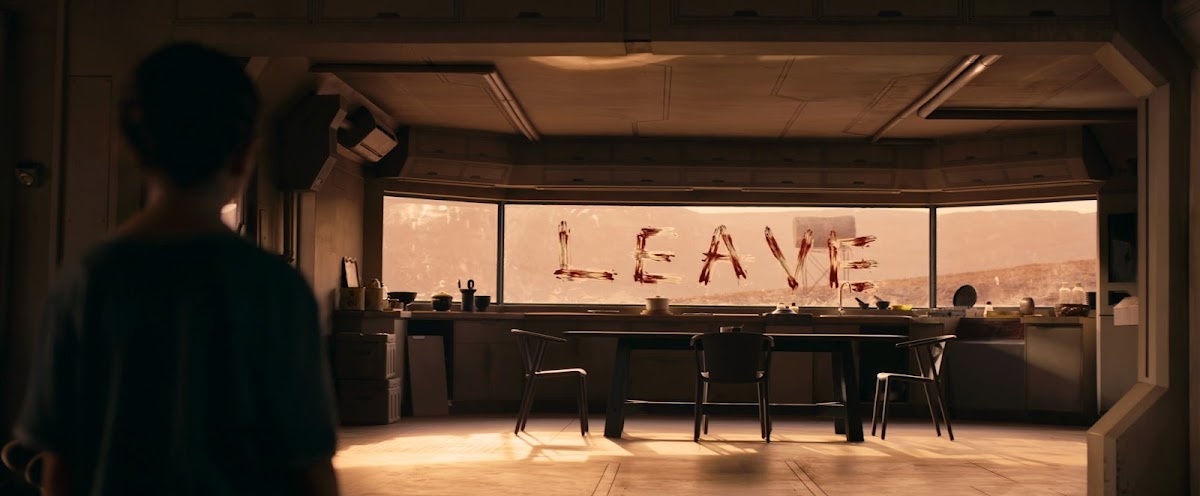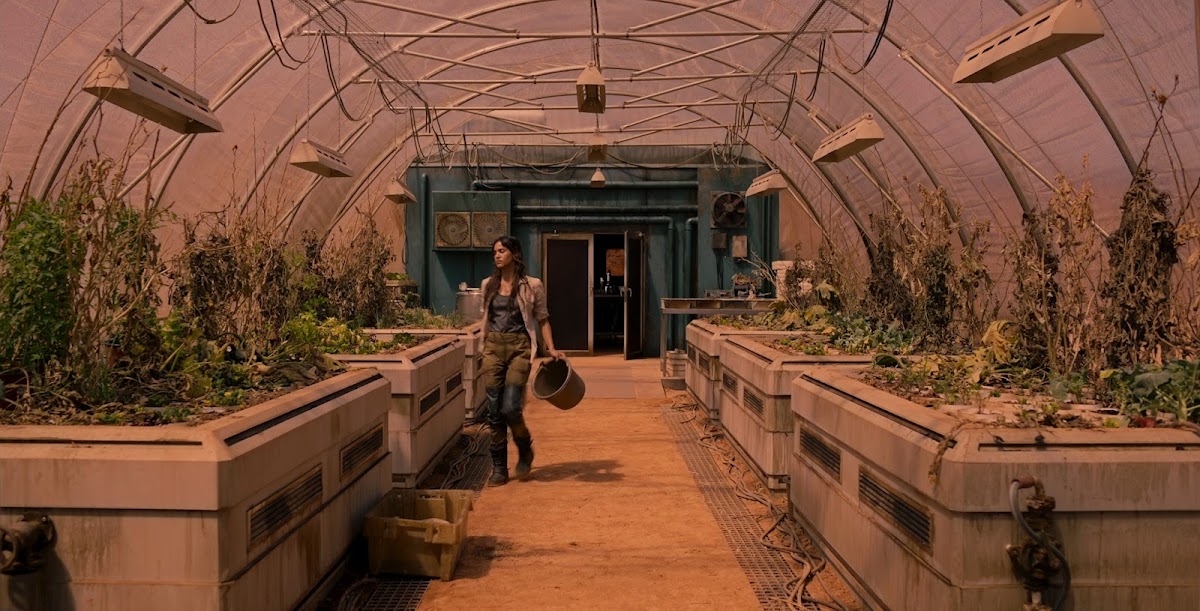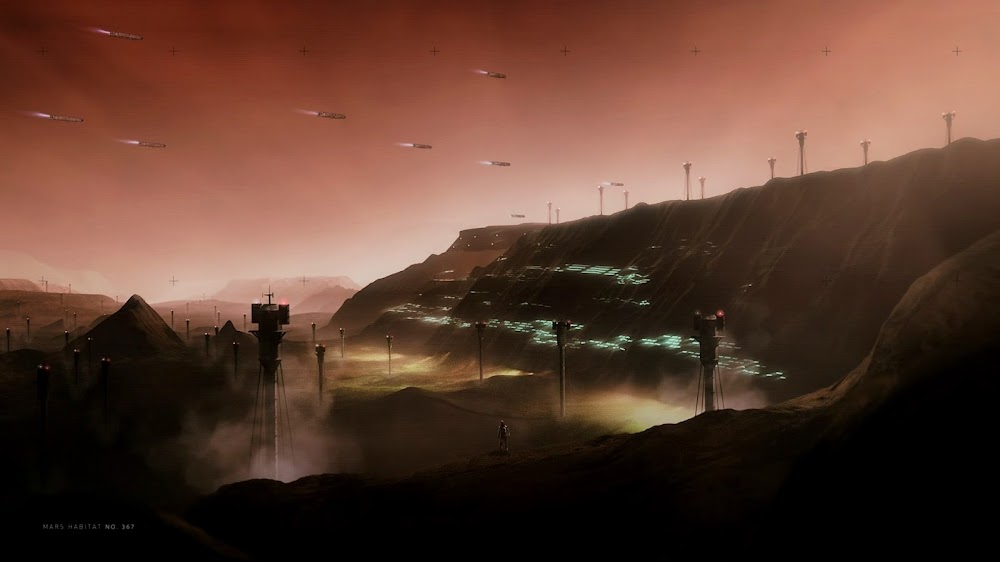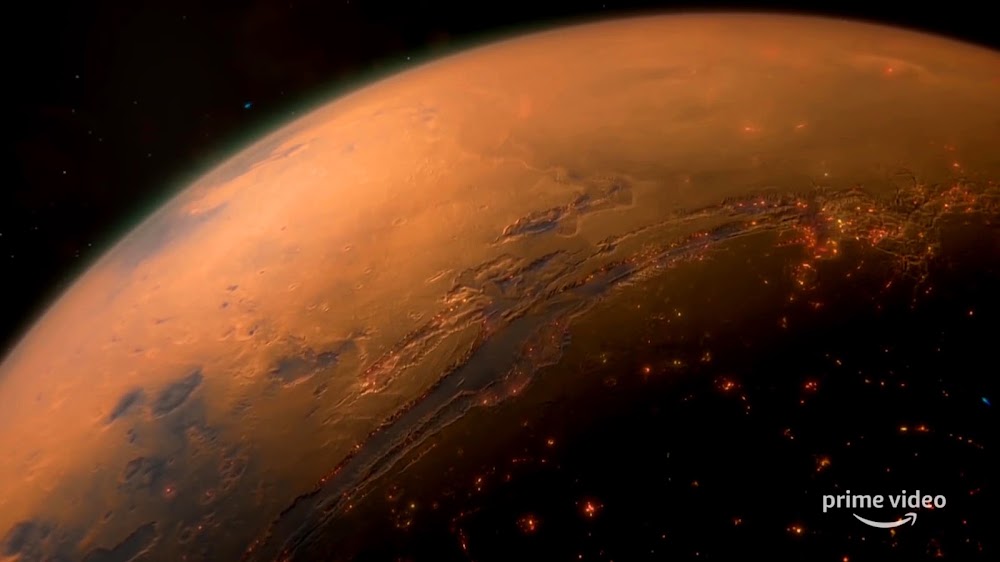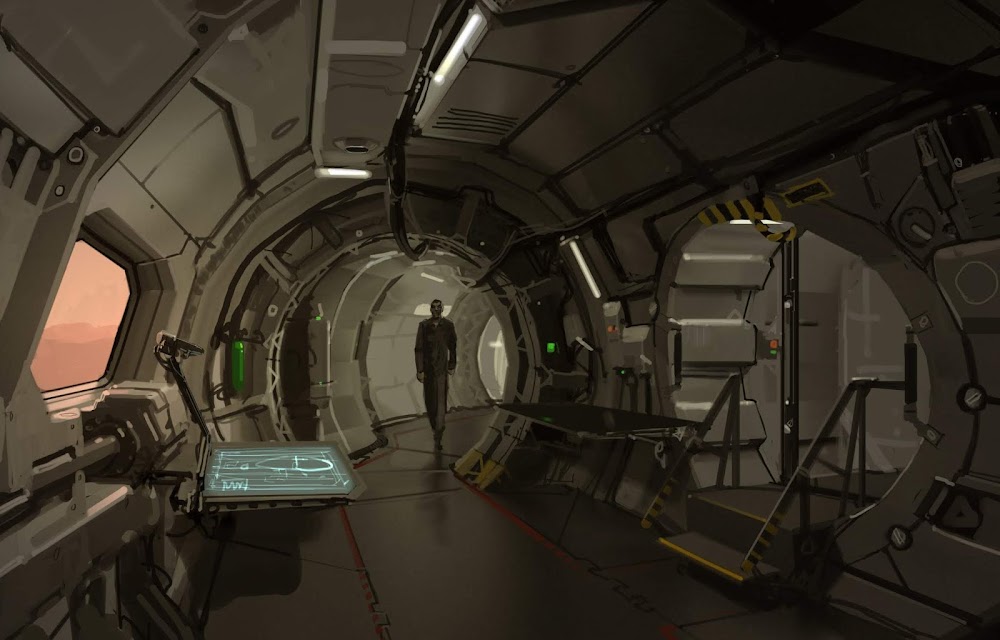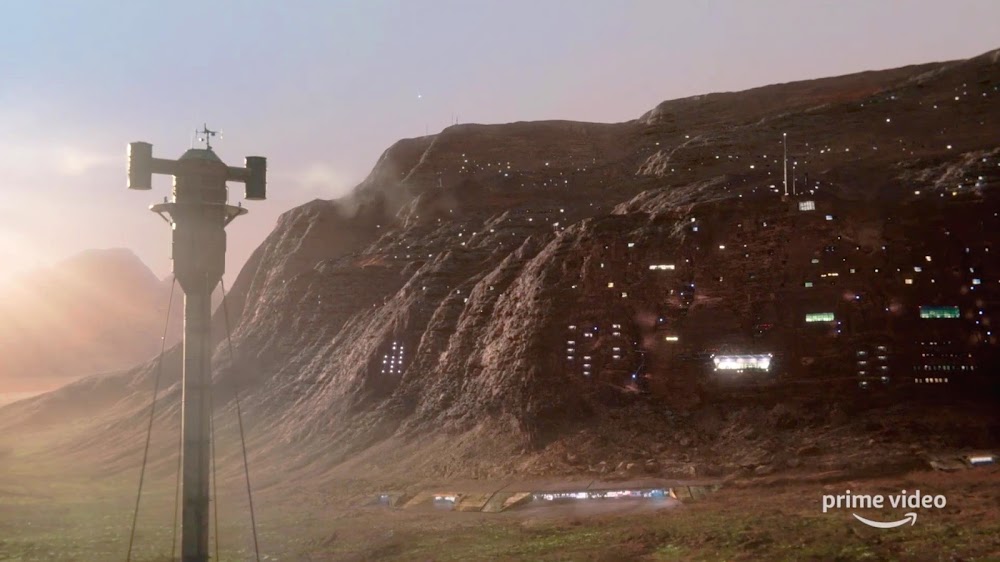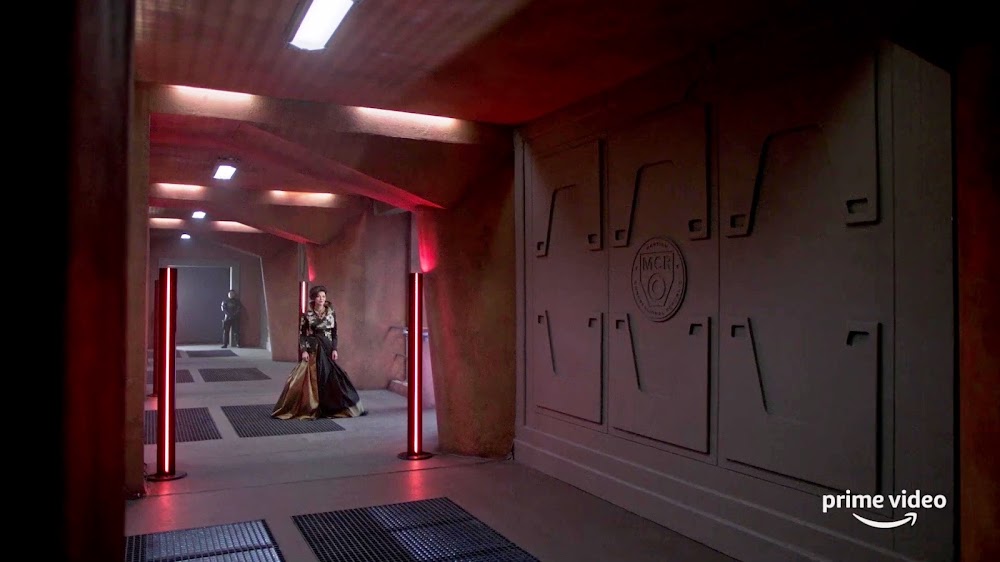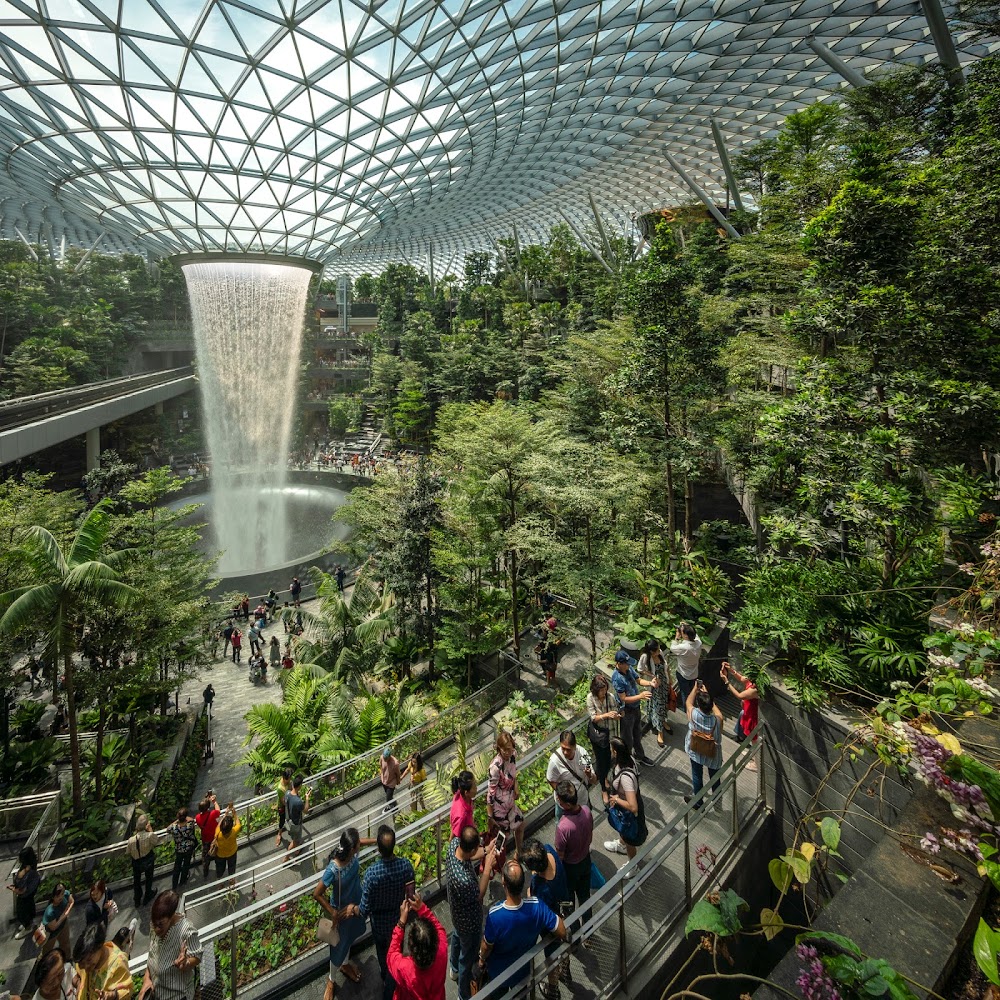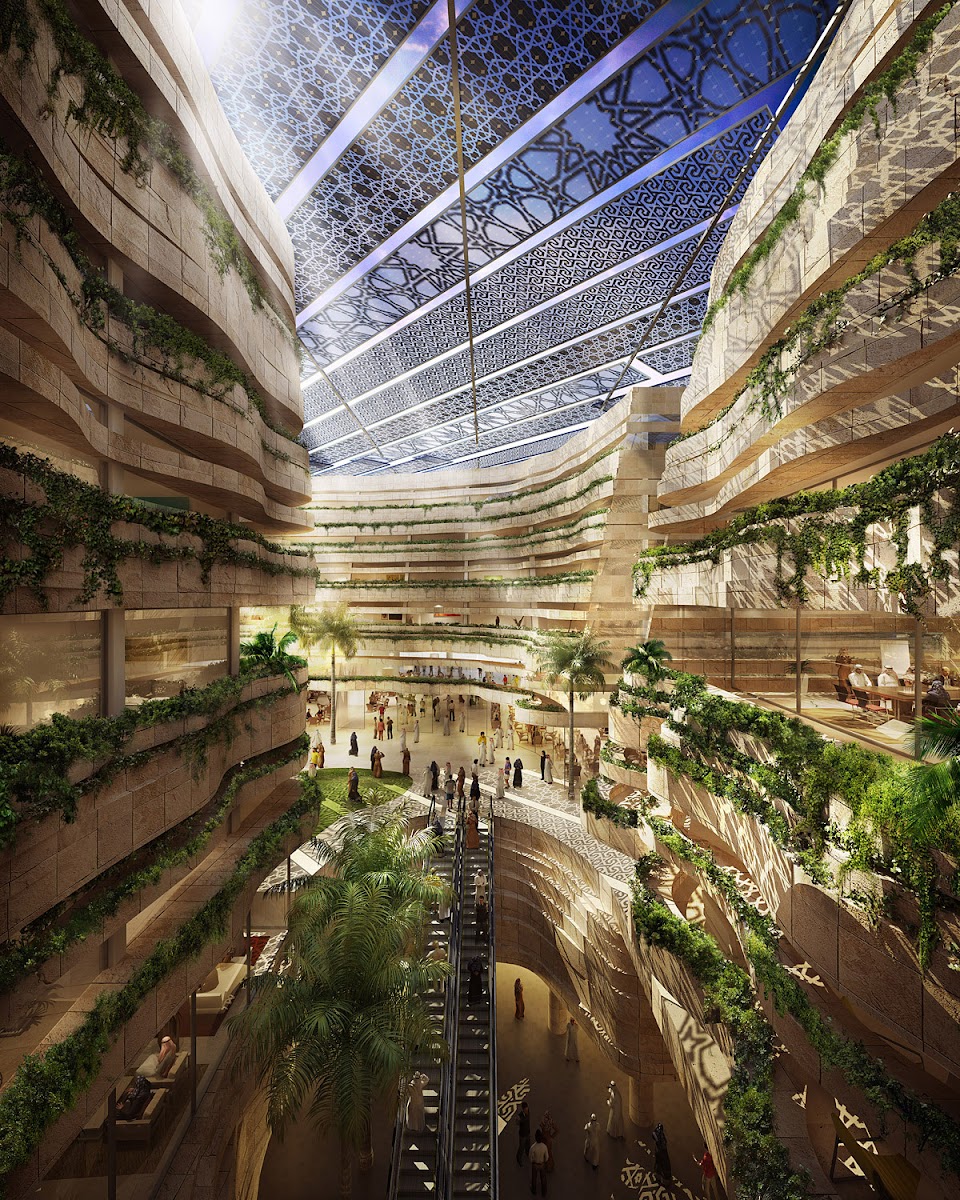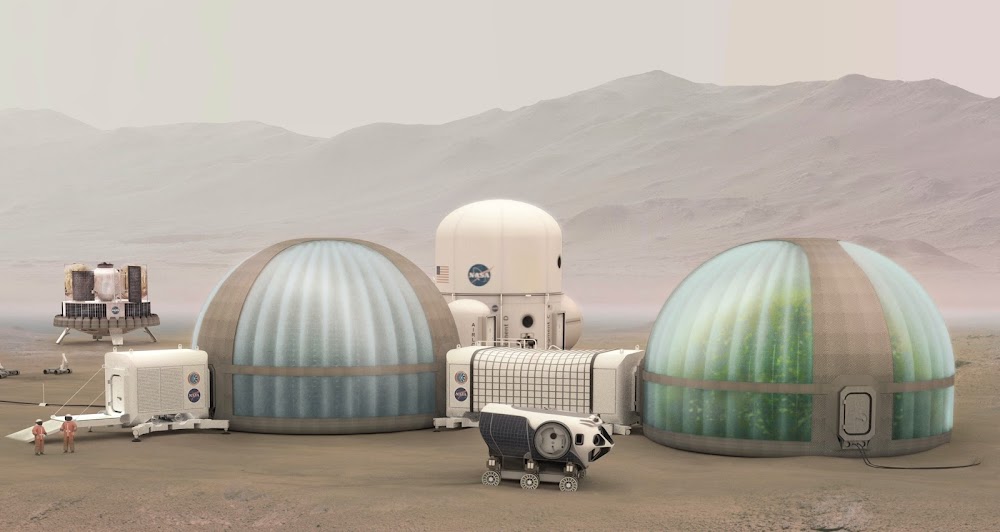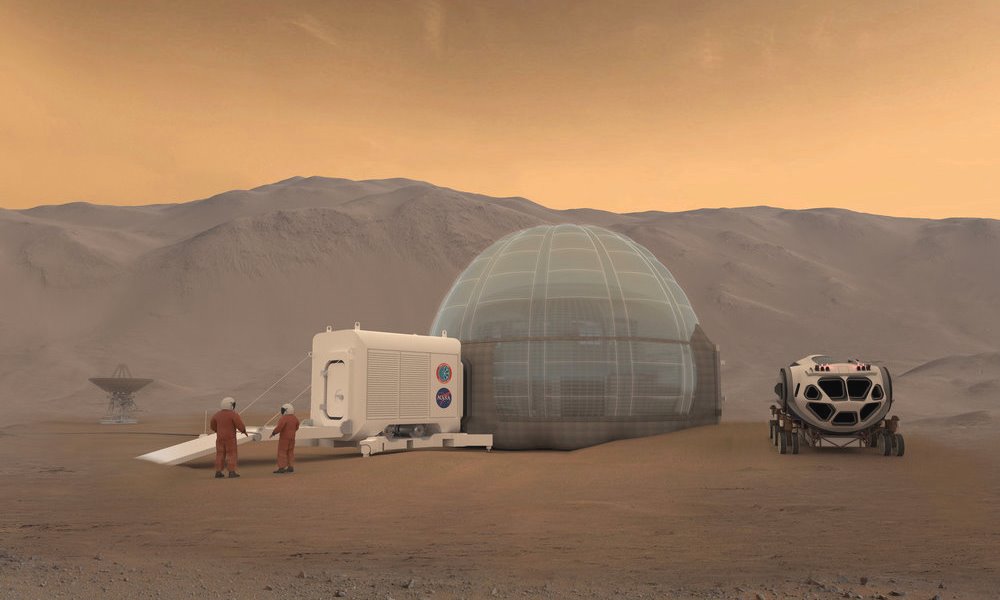A set of renders for a Mars base model created by Polish 3D artist Zuzanna Skąpska for Mission to Mars AR app, an interactive augmented reality experience allowing users to drive a rover, launch a rocket, and explore the Red Planet. The app was created by Immersion Labs for Smithsonian Institution and with collaboration with NASA.
The Mars base model presents a modular and expandable habitat system intended for human settlement on Mars. It comprises multiple interconnected cylindrical modules, each serving distinct functions such as living quarters, research labs, or storage. The central module, marked with "MARS 2020" and an American flag, serves as the primary living area, equipped with communication equipment and access points for surface operations. Adjacent to this is a domed greenhouse structure, crucial for growing food and supporting human life in the base. The design incorporates protective features against Mars' harsh conditions, including radiation shielding, and allows for future expansion as the base grows.
Showing posts with label Mars base interior. Show all posts
Showing posts with label Mars base interior. Show all posts
Sunday, April 6, 2025
Saturday, September 28, 2024
Garden inside a dome on Mars by Bryan Versteeg
Canadian concept artist Bryan Versteeg has created a concept of a human base on Mars featuring a recreational garden inside a small crater covered with a transparent dome.
Saturday, July 20, 2024
A long night on Mars in "Fort Solis" thriller game
Fort Solis (2023) is a cinematic narrative-driven science fiction thriller game set in 2080 on Mars. During a night engulfed in a severe sandstorm two mining engineers, Jack and Jessica, respond to an unusual emergency alert from a mining and research station "Fort Solis". The station is on lockdown and seems to be abandoned. The pair separately starts to investigate, what has happened in the base, searching for clues throughout the claustrophobic buildings. Piece by piece they unlock both the various parts of the base and the truth behind recent events there. The game starts as a detective and ends as a thriller.
Fort Solis runs on Unreal Engine 5.2 so visually it is really good, especially the character models and animations. The game is not long, you can finish it in 5 to 8 hours even when reading, watching and listening to all of the clues throughout the base. The story will unfold linearly piece by piece, but there are two separate endings possible in the final act of the game.
Fort Solis runs on Unreal Engine 5.2 so visually it is really good, especially the character models and animations. The game is not long, you can finish it in 5 to 8 hours even when reading, watching and listening to all of the clues throughout the base. The story will unfold linearly piece by piece, but there are two separate endings possible in the final act of the game.
Visual recap of Fort Solis' STORY
Jack and Jessica are working at a mining rig on Mars
When receiving the emergency allert Jack is driving to the mining station "Fort Solis"
"Fort Solis" is on lockdown
Wednesday, January 10, 2024
Mars base for 200 people in "For All Mankind" season 4
Season 4 of For All Mankind alternate history sci-fi TV series, depicting alternate 2003, "is really about the building of a new civilization on Mars" by the words of the co-creator of the series Ben Nedivi. The international Happy Valley Base, founded in 1995 during season 3 and located in Melas Chasma in the Valles Marineris canyon system on Mars, has been significantly expanded and there are around 200 people living in the base during season 4. The base is financed and operated by Mars-7 Alliance (consisting of US, USSR, ESA, North Korea, India, Japan, and the Coalition of Communist Countries for Spaceflight (CCCS)) and maintained by a private company Helios Aerospace.
Ground level of the base features several separate facilities for power generation, communications, fuel refinement, regolith processing, algae production, storage etc. and a central interconnected cluster of modules consisting of the Entrance hall for new arrivals with airlocks for the rovers, control rooms, laboratories, hydroponic farms, meeting rooms, warehouses / garages, a cafeteria, as well as the quarters for higher level personnel and astronauts / cosmonauts. The base has 5 underground sublevels, of which level 4 & 5 are still under construction in 2003 and not accessible. The sublevels house maintenance and storage rooms and additional quarters for workers. There is also a separate North Korean sector accessible only to North Koreans. The base also operates six landing pads for their orbital Hopper shuttles.
The design of the Happy Valley Base in For All Mankind is the most plausible design of a mid-sized human base on Mars that we have ever seen in a TV series or film.
For All Mankind is exploring the idea of never ending space race if Soviets would have beaten US in the race for the Moon and the intention of the show is each season to jump about a decade further into the increasingly diverging reality of the show: in season 1, depicting alternate 1969 to 1974, both Soviets and US start building their separate bases near the lunar South pole; in season 2 (1983) both bases have been expanded and the superpowers compete for resources on the Lunar surface; in season 3 (1992 to 1995), Soviets and US are joined by a private company Helios and North Korea for a four way race to be first on Mars; in season 4 (2003) there is a sprawling international human base on Mars and an unexpected side enters the race to get hold on a large, lithium-rich asteroid for mining.
Here we collected high resolution shots from season 4 (downscaled from 4K UHD screens for better image quality) depicting the exterior and interior of Happy Valley Base on Mars. No images revealing major story plots are included. We will make a separate article with season 4 story spoilers after the last episode will be released on January 12. [UPDATED:]
How to steal an asteroid .. "For All Mankind" season 4
Ground level of the base features several separate facilities for power generation, communications, fuel refinement, regolith processing, algae production, storage etc. and a central interconnected cluster of modules consisting of the Entrance hall for new arrivals with airlocks for the rovers, control rooms, laboratories, hydroponic farms, meeting rooms, warehouses / garages, a cafeteria, as well as the quarters for higher level personnel and astronauts / cosmonauts. The base has 5 underground sublevels, of which level 4 & 5 are still under construction in 2003 and not accessible. The sublevels house maintenance and storage rooms and additional quarters for workers. There is also a separate North Korean sector accessible only to North Koreans. The base also operates six landing pads for their orbital Hopper shuttles.
The design of the Happy Valley Base in For All Mankind is the most plausible design of a mid-sized human base on Mars that we have ever seen in a TV series or film.
For All Mankind is exploring the idea of never ending space race if Soviets would have beaten US in the race for the Moon and the intention of the show is each season to jump about a decade further into the increasingly diverging reality of the show: in season 1, depicting alternate 1969 to 1974, both Soviets and US start building their separate bases near the lunar South pole; in season 2 (1983) both bases have been expanded and the superpowers compete for resources on the Lunar surface; in season 3 (1992 to 1995), Soviets and US are joined by a private company Helios and North Korea for a four way race to be first on Mars; in season 4 (2003) there is a sprawling international human base on Mars and an unexpected side enters the race to get hold on a large, lithium-rich asteroid for mining.
Here we collected high resolution shots from season 4 (downscaled from 4K UHD screens for better image quality) depicting the exterior and interior of Happy Valley Base on Mars. No images revealing major story plots are included. We will make a separate article with season 4 story spoilers after the last episode will be released on January 12. [UPDATED:]
How to steal an asteroid .. "For All Mankind" season 4
Sunday, October 30, 2022
Desolate life at a homestead on Mars in Settlers (2021) movie
Settlers (2021) is a British science fiction thriller set in a Martian frontier. A small family of early settlers live alone at a homestead in a valley protected by a force field bubble that keeps breathable air inside, but soon their lonely existence is disturbed by a group of intruders. I won't spoil the plot twists of the thriller, but it has major Wild West vibes there. Here is a collection of HD screens from the movie:
Sunday, March 21, 2021
Martian colonies in season 5 of The Expanse
Mars is one of the three competing powers in universe of The Expanse TV series - a political sci-fi drama set a few centuries in the future where humans have colonized the entire Solar system. Mars, governed by Martian Congressional Republic, is a militaristic and technologically advanced society of over nine billion inhabitants. Martian society had been highly mobilized towards the shared goal of terraforming Mars for over a century but in season 4 that shared goal and order of the Martian society was starting to erode as the new habitable planets beyond the rings were discovered and people realized they could build a new home there without the costly need of terraformation. That erosion continues in season 5.
In Martian scenes of season 5 the show focuses on depicting Asteria Naval Base (or Asteria NB) which is a military base and war college of the Martian Congressional Republic Navy (MCRN). Here is a collection with HD images from the Martian scenes in season 5 of The Expanse (open link in new tab to view in full resolution).
In Martian scenes of season 5 the show focuses on depicting Asteria Naval Base (or Asteria NB) which is a military base and war college of the Martian Congressional Republic Navy (MCRN). Here is a collection with HD images from the Martian scenes in season 5 of The Expanse (open link in new tab to view in full resolution).
Exterior and interior of the Asteria Naval Base:
Martian mass transit network crosses canyons on cables and runs deep under ground:
Saturday, February 6, 2021
Family watching news on terraformed Mars
Family watching news in their room at a human colony on partially terraformed Mars - a concept artwork by Portuguese fantasy artist Tiago da Silva (Grafik) created for upcoming computer game Terraformers. It is a Mars colonization strategy game currently being developed by indie game developer Asteroid Lab.
Note the news ticker below the main story in TV displaying: Carl Sagan National Museum opens new exhibit, "The first missions - Elon Musk" :)

Note the news ticker below the main story in TV displaying: Carl Sagan National Museum opens new exhibit, "The first missions - Elon Musk" :)

Sunday, September 27, 2020
Underground oasis in a Martian lava tube
 Shane Powers (USA) & Linjie Wang (China) have created a design of an artificial underground oasis in a Martian lava tube for Marstopia international design contest held by Eleven Magazine. Their design named "Below Freezing" won the "honourable mention" award in the contest. Its main feature, besides utilizing natural lava tubes, is a vertical transportation system (surrounded by 3D-printed ice walls) to Mars's surface. Martian lava tubes could become very handy in creating large, radiation-protected spaces for future human colonists on Mars.
Shane Powers (USA) & Linjie Wang (China) have created a design of an artificial underground oasis in a Martian lava tube for Marstopia international design contest held by Eleven Magazine. Their design named "Below Freezing" won the "honourable mention" award in the contest. Its main feature, besides utilizing natural lava tubes, is a vertical transportation system (surrounded by 3D-printed ice walls) to Mars's surface. Martian lava tubes could become very handy in creating large, radiation-protected spaces for future human colonists on Mars.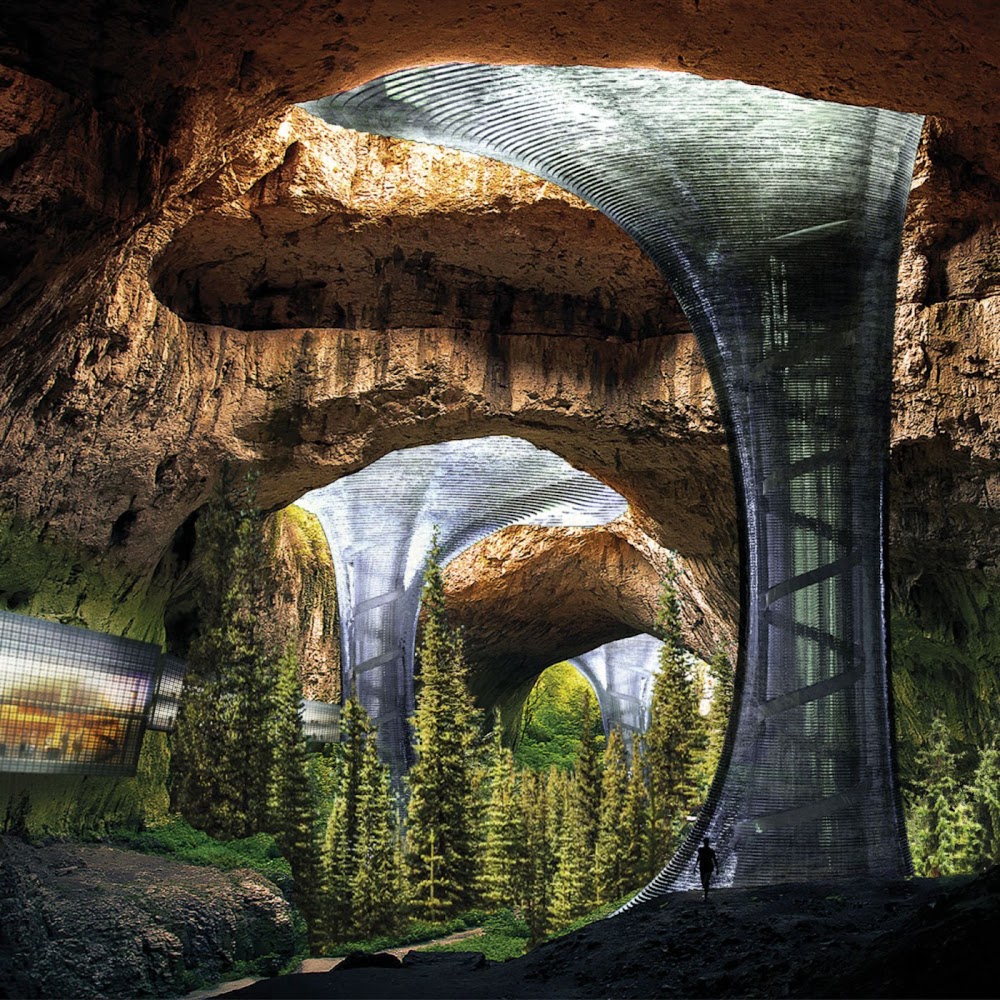
Saturday, September 19, 2020
Canteen at human colony on Mars by Ozgur Saral
Concept of a canteen interior at human colony on Mars by Turkish CG artist Ozgur Saral. More of his art here.
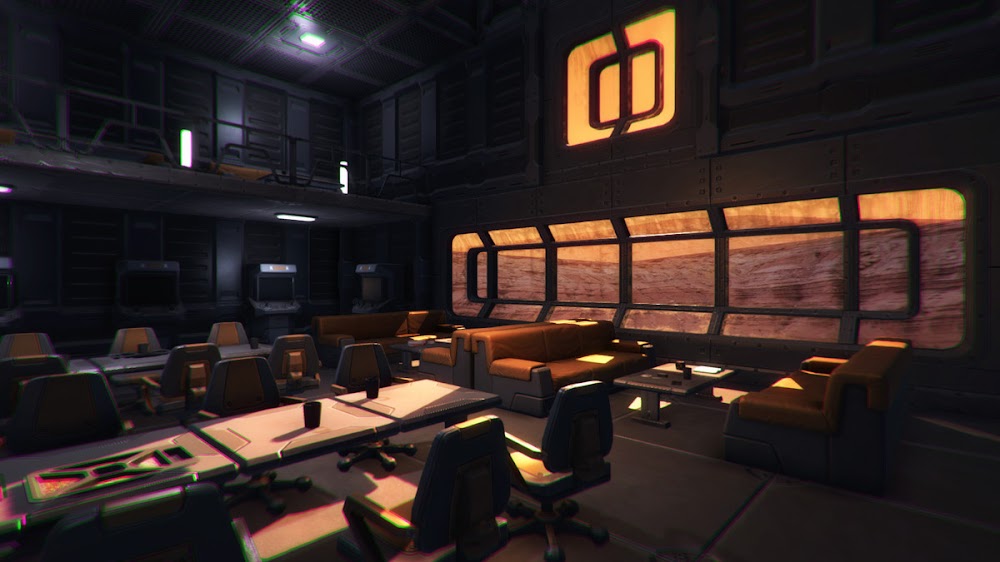

Full demo of the CG concept:
Friday, September 4, 2020
Earthscrapers (inverted underground skyscrapers) could be perfect for Mars
When building on Mars you need to seriously consider measures to protect the inhabitants from cosmic radiation. You can cover your very first Martian outpost with few meters of regolith or use expensive materials with radiation blocking properties but for larger structures the obvious choice is to build underground. Lava tubes could be a solution but they are not present everywhere on Mars. So most likely you will need to dig your habitats.
One of the building types perfect for Mars could be earthscrapers (or would you call them marsscrapers on Mars?) - inverted underground skyscrapers with large vertical central void (covered with a transparent dome on the surface) for natural lighting. The living and public space is arranged in multiple levels encircling that central void. Here is an example of such structure designed by Fernando Castiñeira, Hernan Goldfarb, Alejandro Ispani, Alex Nelken, Javier Maratea & Malena Verni for 2007 Skyscraper Competition by eVolo.us

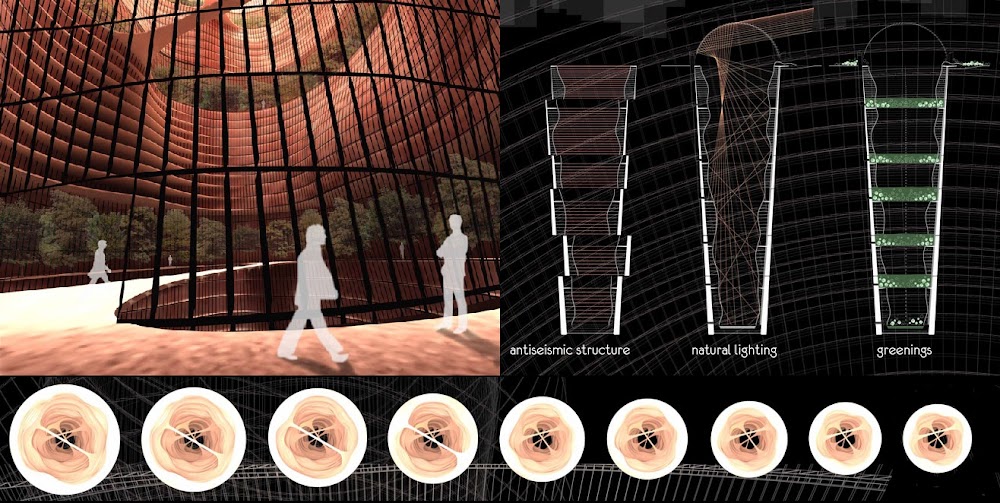
One of the building types perfect for Mars could be earthscrapers (or would you call them marsscrapers on Mars?) - inverted underground skyscrapers with large vertical central void (covered with a transparent dome on the surface) for natural lighting. The living and public space is arranged in multiple levels encircling that central void. Here is an example of such structure designed by Fernando Castiñeira, Hernan Goldfarb, Alejandro Ispani, Alex Nelken, Javier Maratea & Malena Verni for 2007 Skyscraper Competition by eVolo.us

Simple diagram of the design:

Thursday, December 26, 2019
Martian colonies in season 4 of The Expanse
Although Mars is one of the three competing powers in universe of The Expanse TV series (a political sci-fi detective set a few centuries in the future where humans have colonized the entire Solar system) only a few scenes were actually set on Mars in first three seasons of the series. That changes in season 4 where the life on Mars at last gets proper depiction.
In The Expanse Mars, governed by Martian Congressional Republic, is a militaristic and technologically advanced society of over nine billion inhabitants. It is the major competitor of Earth & Luna, governed by United Nations. Earth, dragged down by overpopulation and climate change, envies Mars because of its society's high mobilization towards the shared goal of terraforming Mars. But in season 4 that shared goal and order of the Martian society is starting to erode as the new habitable planets beyond the rings are discovered (without the costly need of being terraformed as Mars does). As the interplanetary military tension is over veterans find themselves needless in the peace time society; crime and corruption is rising, and some even manage to sell older military tech to Belter pirate gangs.
Here is a collection with HD images from the Martian scenes in season 4 of The Expanse (open link in new tab to view in full resolution):
In The Expanse Mars, governed by Martian Congressional Republic, is a militaristic and technologically advanced society of over nine billion inhabitants. It is the major competitor of Earth & Luna, governed by United Nations. Earth, dragged down by overpopulation and climate change, envies Mars because of its society's high mobilization towards the shared goal of terraforming Mars. But in season 4 that shared goal and order of the Martian society is starting to erode as the new habitable planets beyond the rings are discovered (without the costly need of being terraformed as Mars does). As the interplanetary military tension is over veterans find themselves needless in the peace time society; crime and corruption is rising, and some even manage to sell older military tech to Belter pirate gangs.
Here is a collection with HD images from the Martian scenes in season 4 of The Expanse (open link in new tab to view in full resolution):
Exterior and interior of a shipyard for Martian fleet:
Martian school kids training for exam:
Monday, October 14, 2019
Colonized Valles Marineris region on Mars from season 4 teaser of The Expanse
There are two short scenes on Mars in the latest season 4 teaser for The Expanse TV series - a political sci-fi detective set a few centuries in the future where humans have colonized the entire Solar system; Mars is one of three competing forces in the universe of The Expanse. There were three more scenes on Mars in the first teaser for season 4.
Human colonies in Valles Marineris region (horizontally flipped in the trailer for some unknown reason) on Mars:
Earth's leader Avasarala attending a diplomatic banquet on Mars:
⇛ HD images of Mars from season 2 of The Expanse TV series here
Thursday, August 22, 2019
Mars base paintings by Romek Delimata
Here are several digital concept paintings of a human base on Mars by British film artist Romek Delimata, who has worked for such well-known movies / TV series as Interstellar, First Man, Westworld, Game of Thrones, Guardians of the Galaxy, Behind Enemy Lines etc. These images were made for The Last Days on Mars (2013) - a zombie virus horror thriller set on Mars.
Mars base at night:
Mars base interior:
Another version with different configuration and a rover parked next to the base:
Tuesday, August 13, 2019
Mars colony bored into a mountain from season 4 teaser of The Expanse
Two weeks ago came out the first season 4 teaser for The Expanse TV series - a political sci-fi detective set a few centuries in the future where humans have colonized the entire Solar system; Mars is one of three competing forces in the universe of The Expanse. There are two three short scenes on Mars in the teaser.
Human colony bored into a Martian mountain:
Shuttle over colonized Mars:
Earth's leader Avasarala in Martian tunnel:
⇛ HD images of Mars from season 2 of The Expanse TV series here
Monday, August 12, 2019
Domed park with central waterfall on Mars
Design of what could be a domed park with central, artificial waterfall and public space on Mars by Safdie Architects. These are design images for 1.3 billion $ Jewel Changi Airport project opened on April 2019 in Singapore. The Jewel is a connector hub for Singapore's Changi Airport terminals, designed in shape of glass & steel torus dome with world's tallest indoor waterfall in the center and multi-level marketplace & public space hidden inside gardens on the terraces and in canyons around it.
Shops and restaurants are well hidden inside gardens:
Thursday, July 4, 2019
Mars colony in artificial, domed canyon
Picture of the Day 4/7/2019 - design of what could be a human colony in a narrow, artificial, domed canyon on Mars by LAVA architects. This image was done for a design of Masdar City (next to Abu Dhabi, United Arab Emirates) - a futuristic sustainable city project in development and intended to be a hub for cleantech companies.
Tuesday, July 2, 2019
Mars Ice Home concept by NASA, SEArch+ & Clouds AO
Mars Ice Home is a feasibility study conducted at NASA Langley Research Center in 2016 in collaboration with human-centered space design studio SEArch+ and architects from CloudsAO. Responding to the problem of galactic cosmic radiation being the most significant issue for human health on long duration Mars surface missions, the concept incorporates in situ resource utilization derived water-ice for radiation shielding and as a structural component.
Water, a hydrogen-rich material, is an excellent shielding material for galactic cosmic rays – and many areas of Mars have abundant water ice just below the surface. The Ice Home concept balances the need to provide protection from radiation, without the drawbacks of an underground habitat. The design maximizes the thickness of ice above the crew quarters to reduce radiation exposure while also still allowing light to pass through ice and surrounding materials. The water-ice fills and freezes within cellular pockets of the precision-manufactured inflatable membrane. The interior of the habitat would be insulated from the ice with a cellular layer of carbon dioxide, which can easily be extracted from the Martian atmosphere.
Water, a hydrogen-rich material, is an excellent shielding material for galactic cosmic rays – and many areas of Mars have abundant water ice just below the surface. The Ice Home concept balances the need to provide protection from radiation, without the drawbacks of an underground habitat. The design maximizes the thickness of ice above the crew quarters to reduce radiation exposure while also still allowing light to pass through ice and surrounding materials. The water-ice fills and freezes within cellular pockets of the precision-manufactured inflatable membrane. The interior of the habitat would be insulated from the ice with a cellular layer of carbon dioxide, which can easily be extracted from the Martian atmosphere.
Subscribe to:
Posts (Atom)











